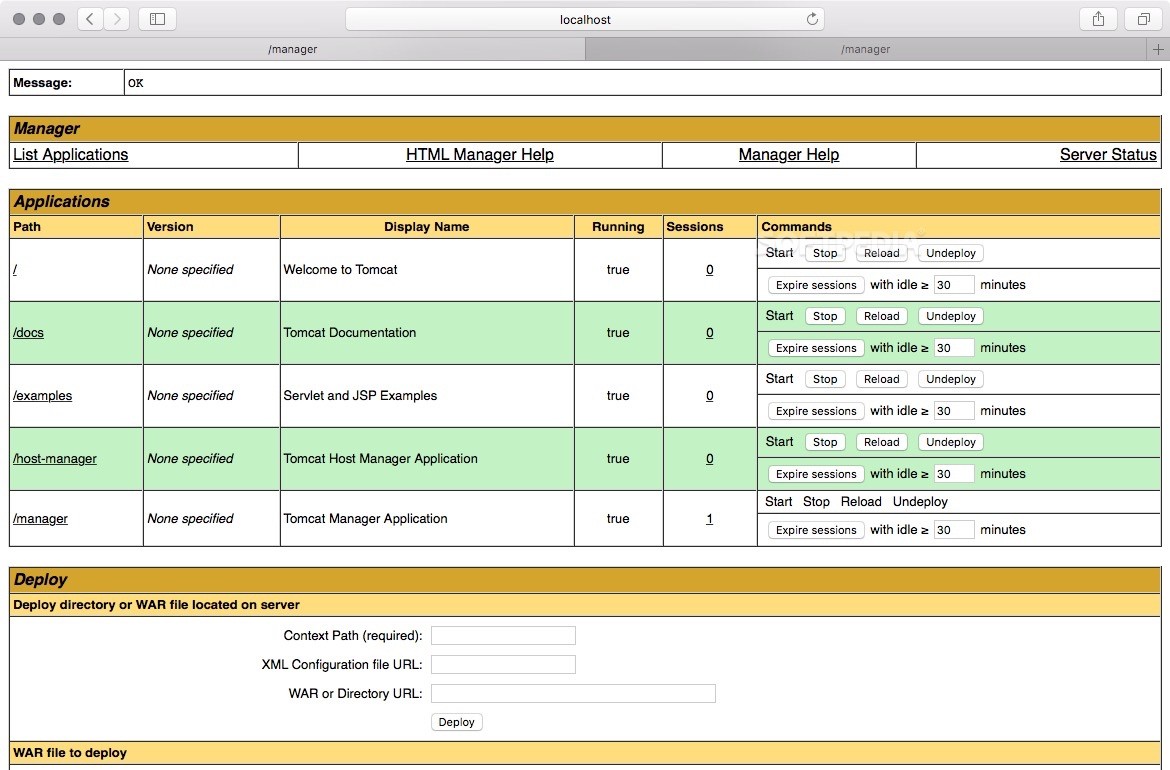Tomcat 7 Mac Download
Apache is the most widely used web server software which is developed and maintained by the Apache Software Foundation. It is an open source software. Apache Tomcat is used to deploy Java Servlets and JSPs. So basically Apache is an HTTP Server, serving HTTP. Tomcat is a Servlet and JSP Server serving Java technologies.
Install Apache Tomcat 7 server
1st Step: Go to http://tomcat.apache.org ⇒ Download ⇒ Tomcat 7.0 ⇒ 7.0.{xx} (where {xx} denotes the latest release) ⇒ Binary distribution ⇒ Core.
- Free tomcat 7.0.47 download software at UpdateStar - Tomcat allows user to deploy an application in an unpacked directory like this, either by copying it to the. It via the 'Manager' web application. The latter approach is very useful during development, and will be illustrated below.
- Apache tomcat 7 mac os. ArcGIS Desktop; Quantum GIS (QGIS) LTR – also for Mac of vertical conversion algorithms, which is convenient if you want to work with X,Y,Z- data) be installed on Mac OS platforms, in contrast to ArcGIS Desktop which is only For use at home, you can download.
Download the “tar.gz” package (e.g., “apache-tomcat-7.0.{xx}.tar.gz“). Next extract the tar.gz folder to the apache-tomcat-7.0.{xx} folder. Rename the folder to “tomcat” and copy the extracted folder.
Go the Applications folder, and paste the tomcat folder.
Configure the Apache Tomcat server
Welcome to the Apache Tomcat ® 7.x software download page. This page provides download links for obtaining the latest version of Tomcat 7.0.x software, as well as links to the archives of older releases. CNET Download provides free downloads for Windows, Mac, iOS and Android devices across all categories of software and apps, including security, utilities, games, video and browsers.
The following files in the /Applications/tomcat/conf folder will be edited in order to configure the server.
- web.xml
- context.xml
- server.xml
Set the TCP Port number

The /Applications/tomcat/conf/server.xml file will be edited to change the port number which runs the apache tomcat server. The default port number the server runs is 8080. This can be run on the default port number if no other application is running on this port. If not you can change the port number by replacing 8080 as follows in the server.xml file (around Line 69).
You may choose any number between 1024 and 65535.
Enabling Directory listing
In order to enable directory listing the /Applications/tomcat/conf/web.xml file needs to be edited as follows. Change the value “false” to “true” in the parameter value under listings (around line 103).
Enabling Automatic Reload
Change the /Applications/tomcat/conf/context.xml file (around line 19) as follows. Insert the reloadable=”true” statement inside the context tag.
The configuration of the Apache Tomcat server is complete.
Start the Apache Tomcat server
To start the Apache Tomcat server, open a new terminal and change the working directory as follows.
Next type the following command in order to start the server.
If you receive an error saying “command not found” or “cannot start server”, do the following to change the permissions of the catalina.sh file. This should have execute permissions for the server to start.
Next run the following command again to start the server.
Now the server should start correctly and the terminal should display a message saying “Tomcat started”.
Thank You!


Posted on Sep 12, 2014 | 0 comments
In this short tutorial you will learn:
- How to install Tomcat on the Mac OS-X
- How to add DimensioneX into Tomcat so that you have a multiplayer game server up and running
Installing Tomcat
Open Terminal first and type
java -version
Apache Tomcat Download 7
The prerequisite is to have at least Java 1.6.0 installed so if you get an error here or you have an old version installed, you need to get and install Java from Oracle’s Java Download page.
Download the so-called binary distribution (that is, ready to run) of Tomcat, the core module. What you need is a file named something like apache-tomcat-7.0.**.tar.gz which should be available here. Look under Binary Distributions -> Core
Unpack this archive by double-clicking it. You should have now a folder (mine was named apache-tomcat-7.0.55/ )
Back to the Terminal window, rename this folder to simply “tomcat” then move it inside the /usr/local/ folder of your mac, creating it if it not exists. Here is a sample command sequence to do this (adapt to your own case):
sudo mkdir -p /usr/local
sudo cd ~/Downloads/
sudo mv apache-tomcat-7.0.55 tomcat
sudo mv tomcat /usr/local
Now let’s make all the scripts executable:
cd /usr/local/tomcat/binsudo chmod +x *.sh
Default page fter starting Tomcat
Starting Up Tomcat
Do it first from the Terminal window:
/usr/local/tomcat/bin/startup.sh
then open your browser at http://localhost:8080/ – it should look as follows (see figure)
Hooray!
You can shut down Tomcat with:
/usr/local/tomcat/bin/shutdown.sh
In order to make life easier, however, I recommend to download and use this little free utility Tomcat Controller, so that you can start/stop from a nice interface and even change the path to Tomcat should you update it.
Just access its Preferences menu to set correct paths.
Installing DimensioneX
Download from our Download page the WAR version of DimensioneX. You will get a ZIP file which, again, you will unpack by double-clicking. You have now got a dimx.war file (war is the short for WebARchive) which is ready to install on your Tomcat.
For this, we need to gain access to Tomcat’s builtin “manager” application.
Therefore, open Terminal and type:
cd /usr/local/tomcat/confsudo nano tomcat-users.xml
Copy-paste (or move, because they should be already in the file) the following text lines outside of the <!– –> comments delimiters, othewise they will be ignored.
<role rolename=”manager-gui”/> <user username=”tomcat” password=”s3cret” roles=”manager-gui”/>
please customize the “s3cret” string with a password of your choice, using the default password may leave your Tomcat server open to external access control, which of course you want to avoid.
Type CTRL-X to exit and then Y for Yes to confirm the file save.
Now it’s time to open again your browser at
http://localhost:8080/manager/html/
After entering your tomcat manager credentials:
user: tomcat
password: s3cret (or better the password you’ve just chosen)
you are now at the Tomcat’s manager screen. Scroll down to the Deploy section, then click Browse button and select the dimx.war file you have just unpacked some minute ago.
click Deploy
Verify that now dimx is in the applications list and, what’s more important, that you can access your brand new DimensioneX multiplayer game server at:
Tomcat 9 Download
http://localhost:8080/dimx/
Have a nice play at our demo games… this tutorial is over!
Credits
Tomcat 7 Mac Download Softonic
Thanks Wolf Paulus for his tutorial on the topic http://wolfpaulus.com/jounal/mac/tomcat7/
